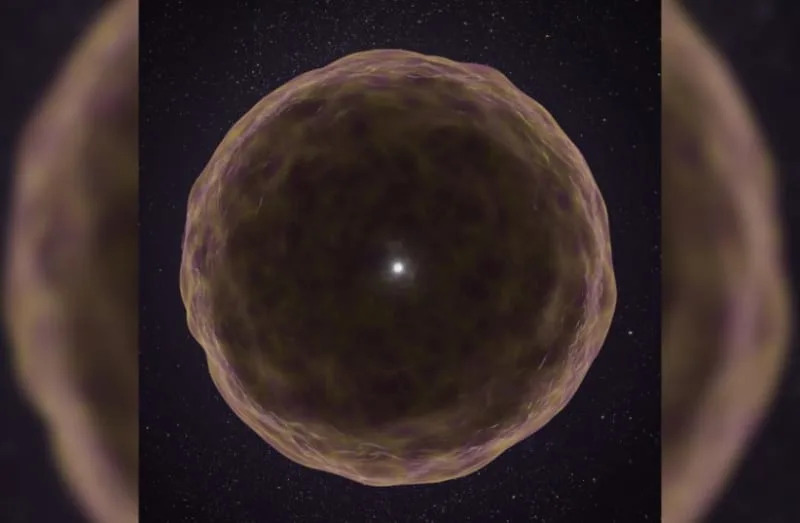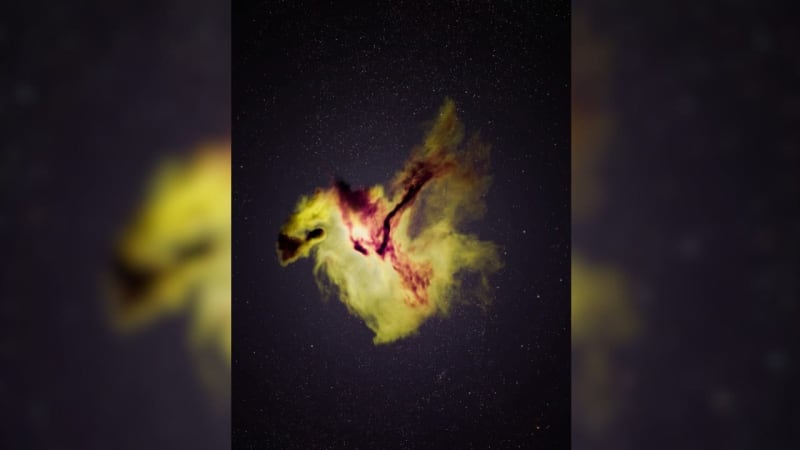Israeli and American scientists have uncovered a never-before-seen type of supernova, shedding light on how stars produce and expel heavy elements like silicon and sulfur during their violent deaths.
Israeli and American scientists discovered a never-before-seen type of supernova, one that blasts out heavy elements like silicon and sulfur from the body of a dying star, a new study reveals.
The findings of this study were published in the peer-reviewed academic journal Nature, and provide evidence for a long theorized part of stellar anatomy.
All of this was made possible by witnessing an extremely violent and unusual death of a star, the result of which allowed scientists to look deeper than ever before.
Of violence and onions: The death of a star and supernovae
To understand what exactly happened, it’s important to understand what a supernova is and, before that, to understand what a star is.
Stars are, at their core, massive and extremely hot balls of gas, specifically hydrogen and helium. These two elements are very common – in fact, they are so common that they make up almost all matter in the universe.

The explosion left behind an interstellar gas-and-dust cloud rich in silicon (gray), sulfur (yellow) and argon (purple). (credit: Keck Observatory/Adam Makarenko)
So where does everything else come from?
To oversimplify complex astrophysics and chemistry, when these hydrogen and helium come together, they can heat up and new elements can be formed – if the circumstances are right.
Stars are where this happens. These giant balls of gas possess cores that are a lot more solid, specifically made of iron.
The cores are active and are fueled by a process of energy production, which sees the lighter elements to form heavier ones. This is known by nuclear fusion, and it is this process that keeps the star hot, allowing gases to expand while simultaneously drawing its mass toward the core in a delicate gravitational balance.
So that’s how some of the heavier elements are made, but others still need more heat – hotter than what a star’s core can usually handle. What’s more, all those heavier elements are still stuck in the stars. How do they get out and expand into the universe, forming planets and asteroids and more?
The answer is that the star has to die.
When the star can no longer produce energy, it collapses in on itself. When this happens, it results in a massive explosion, one of the most powerful forces of energy in the universe – a supernova. This fuses some of those heavy elements together to make even heavier ones, and all of them get blasted out into the cosmos.
This process is essential to the function of the universe, allowing everything to keep expanding and ultimately sending forth the building blocks of the universe’s continued expansion.
In other words, everything in the universe is made of stardust, and supernovas are what send that stardust out there to accumulate and make new things.
The remnants of that progenitor star are still there, condensing together to form a neutron star or a black hole, or maybe even a diffuse nebula of sorts.
So that’s what scientists have already known. But there is more to this story.
See, stars are a lot like onions and – they have layers. The heavier elements occupy the inner layers, getting heavier and heavier as they get closer to the iron core. The massive outer layers are where those lighter elements, like hydrogen and helium, are.
But this was only a theory. Studying a supernova can be hard, as while the stars that go supernova are always 10-100 times heavier than the Sun, the explosion happens in a fraction of a second. Even still, it’s possible to observe the bright light from the supernova for some time – even weeks can go by without the light fading. But until now, scientists have only ever seen the traces of light elements like hydrogen and helium, rather than anything heavier.
But all of that changed with this study
The now deceased star in question is SN2021yfj, a massive star far heavier than our Sun. In September 2021, the flare from its supernova was spotted by Dr. Steve Schulze, a former member of Weizmann Institute of Science‘s astrophysics team and now a researcher at Northwestern University.
Using the Zwicky Transient Facility telescope in California, Schulze and his team did a spectral analysis. What this means is that they looked at the different colors of the flare’s light. Each color represents a different element, and by observing which colors are present in its spectrum, scientists can figure out what elements are present. In other words, this is how you can use light and colors to figure out what things are made of.
This isn’t exactly easy, though, as intrusive obstacles can get in the way of a spectral analysis. In Schulze’s case, those obstacles came in the form of clouds, stopping researchers from getting a clear enough image.
But someone at the University of California, Berkeley, managed to get it. And the results were shocking.
Normally, when studying a supernova, one expects to see the usual suspects of light and abundant elements, like helium, carbon, oxygen, and so on.
But that’s not what they found. Instead, the light fired out by SN2021yfj with its dying breaths consisted largely of sulfur, silicon, and argon.
That’s not supposed to happen. So how could the supernova just not have the lighter elements, and instead have the far heavier ones?
A cosmic murder mystery: How a star was stripped to its core before death by explosion
The conclusion Schulze came to was that something went wrong. Massive stars like SN2021yfj are, as mentioned previously, like onions – they have layers. And some of those layers have been peeled off.
This itself isn’t unheard of. Stripped stars, as they are known, have been seen before. But those usually have layers made of helium, carbon, or oxygen – exposed when the outermost hydrogen layers were lost somehow.
But SN2021yfj must have had even those layers stripped away. That’s not like just peeling a few layers off an onion. Rather, it’s more like stripping it to the bone – and that’s the part that’s unheard of.
“This star lost most of the material that it produced throughout its lifetime,” Schulze said in a statement. “So we could only see the material formed during the months right before its explosion. Something very violent must have happened to cause that.”
This is not a thing that should happen. As noted by Weizmann’s Dr. Ofer Yaron, a leading expert on supernovae, this level of deep exposure is a major challenge to prevailing theories on how these layers fall away.
Something happened that caused this star to die like this. But what?
Several theories were put forward. A companion star could have theoretically exerted force that caused the layers to be stripped away. Another explosion or strong stellar winds could have been the culprit.
But the main suspect is actually SN2021yfj itself.
The star’s core likely produced so much heat that the nuclear fusion caused an incredibly powerful burst of energy. This then may have caused the star’s layers to be blown apart, sending the outer layers away.
This, essentially, means that SN2021yfj ripped itself apart.
But this may have happened before. In fact, the shed layers may have collided into one another, or into another layer that had been blown out a previous time, and that resulted in another explosion.
But how much does this factor into the death of SN2021yfj? That, currently, is still a mystery. But what is sure is that no one has ever had the chance to look at stellar anatomy this closely, going deeper than anyone has gone before.
“It’s always surprising – and deeply satisfying – to discover a completely new kind of physical phenomenon,” said Prof. Avishay Gal-Yam, whose research group in Weizmann’s Particle Physics and Astrophysics Department focuses on understanding how the elements are formed in the universe. “As soon as I saw the data Dr. Schulze sent me, it was obvious we were witnessing something no one had ever seen before.
“Once we identified the spectral signatures of silicon, sulfur, and argon, it was clear this was a major step forward: Peering into the depths of a giant star helps us understand where the heavy elements come from. Every atom in our bodies and in the world around us was created somewhere in the universe and went through countless transformations over billions of years before arriving at its current place, so tracing its origin and the process that created it is incredibly difficult. Now it appears that the inner layers of giant stars are production sites for some of these important, relatively heavy elements.”
